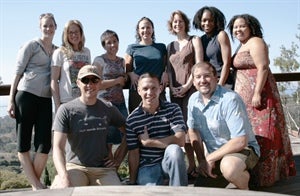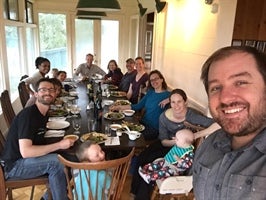Fellowship of the Knauss: A perspective, 10 years later
This March 2016 I found myself in Oregon’s beautiful Applegate Valley, sitting in the very house in which rock-legend Steve Miller wrote several billboard hits. But Mr. Miller was not the reason I was there. Each year the legislative Knauss class of 2006 picks a venue to reunite, and this year Mr. Miller’s abode was almost the exact geomidpoint for us. When I began my 2006 National Sea Grant Knauss Fellowship in the House of Representatives Natural Resources Committee, I knew it would open career doors, giving me fast-track (aka “drinking from a fire hose”) experience at the front lines of ocean policy. What I didn’t know was that this group of fellows, with whom I clearly shared academic and professional interests, would turn out to be one of the funniest, dearest, and loyal groups of friends I have ever had. Perhaps there is something eternally bonding about serving together on the front lines of ocean policy?
The Knauss Fellowship began in 1979 and now boasts a little over 1,100 alumni. That is not a big number, and yet, I run into Knauss Alumni everywhere! And that seems to be everyone’s experience. Either the world of environmental science and policy is relatively small (likely true), or Knauss alumni tend to be passionate people who continue working conspicuously at the forefront of environmental science and policy long after the fellowship is over (also likely true).

Since our fellowship year, the 2006 Knauss legislative fellows have worked as congressional staffers, federal and state policy-makers, environmental advocates, oceanographers, writers, speakers, and even environmental film producers. “The fellowship helped open doors I didn’t even know existed,” said Amber Mace, 2006 Knauss fellow and now Deputy Director of the California Council on Science and Technology. Furthermore, we all agree that the Knauss fellowship continues to help and influence us now a decade later. “The fellowship taught me to see environmental issues from multiple perspectives…that almost everything is more complicated than it seems…and I have dedicated my career to better communication around these complex issues,” said John Meyer, 2006 Knauss fellow and now Assistant Director of Science Communication at the University of Washington College of the Environment.
Fun fact: John actually married another 2006 Knauss fellow, Adrienne Sutton, who after 3 years of policy work, returned to research with the University of Washington—NOAA Joint Institute for the Study of the Atmosphere and Ocean. Adrienne also pulls on her Knauss experience regularly, reporting, “Understanding both the science and policy cultures allows me to operate in both communities, helping to translate between the two and ensure the research I’m involved in always has an eye towards societal benefit.”

There is no doubt that the Knauss fellowship is an unique, invaluable experience that continues to open doors and prepare incredibly hard working young professionals to work at the complicated intersection of science and policy. I think that what has surprised the 2006 class is how close we all have remained personally, allowing our families to grow and grow-up together. In the past decade, we have celebrated five weddings and seven children, as well as supported each through multiple domestic and international moves, major career decisions, medical challenges, and family deaths. So, at our 10th reunion, sitting on Steve Miller’s old couches, house-bound by torrential rain, we listened to our kids play a self-invented game of “scientists and polar bears” in the other room, complete with a snow cave under a bed and melting ice flows and a strange polar bear roaring-dialect. The fellowship continues.
Get ready Sea Grant: the Knauss class of 2036 may already be in the making!